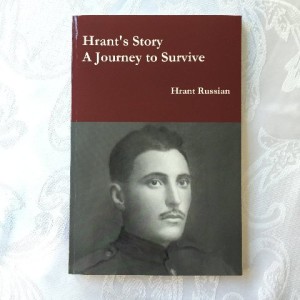One Man’s Survival Journey Reflects Grit
January 13, 2016
LEXINGTON, Mass.—Hrant’s Story: A Journey to Survive is a true eyewitness account of one man’s life and survival in the Armenian Genocide during the early part of the 20th century.
Traveling from Kharpert to freedom, his journey symbolizes the courage and perseverance that Armenians exhibited during that period.
Hrant Russian recorded his story in Armenian on tapes during the last years of his life. Having defied death three times, he felt compelled to chronicle the events in vivid detail. For years it remained dormant, until family members decided to share the story in time for the 100th anniversary of the genocide—30 years after his death.
“I remember as a little girl standing many times behind my father as he sat at his desk doing his bookkeeping and tracing the slit in the back of his bald head,” recalled daughter Sandra (Russian) Aghababian of Lexington, who handled the translation and editing.
“He never told me what it was from until he started to tape his story, and I found out this was a scar from a bullet.”
While the impetus to finish the book was certainly the Centennial, Aghababian said the real reason was the realization of her own age and mortality.
“I had made a promise to my father to finish this project and it was not yet fulfilled,” she added. “Armenians who went through the genocide generally fell into two categories: those like my mother who would not talk about it and those who had a passion to preserve their story.”
Russian recorded his life on many tapes and wanted it published. After some unsuccessful attempts, it was left unfinished.
“Finally, after many years, it was time,” Aghababian said. “Not being a writer, I hesitated wanting to do him justice and finally realized that his words and story were most important.”
Aghababian recruited the help of her brother Hrant, an attorney on Cape Cod, and together they were able to document their father’s legacy. While Sandy initiated the writing and translation, her brother provided many of the old photos from their father’s life.
Aghababian’s daughter Pamela, a librarian by trade, found the publishing site and walked her mother through the internet process. The book is available on Lulu.com.
The story warms any reader’s heart, and is well written, documented, and told in a provocative way. After immigrating here in 1923, Hrant realized that having an Americanized name was easier, so he adopted “Henry.”
He eventually wound up with his own grocery story—Henry’s Market—in Cambridge and was very successful both in real estate and other investments.
He wed Pegrouhi “Peggy” Tashjian in 1934 through an arranged marriage. Their love and commitment toward one another only grew stronger over the 50 years that followed. The family ultimately settled in Belmont.
“For a man who toiled the earth in his youth, he never lost his passion for gardening,” said Aghababian. “Every summer we would go to the Catskills where he would gaze over the mountains, lost in his own reverie for the homeland.”
Although he worked very long hours, Hrant took pride in being instrumental in the formation of St. Stephen’s Church in Watertown. He was also a devoted ARF member.
“My father’s only regret was seeing his education cut short,” Aghababian noted. “Through hard work, he still achieved the life of his dreams. For a man who defied death three times, he was never bitter and counted his many blessings right up until his death in 1985.”
As a mother of three and grandmother of three, Aghababian knows the value of family inculcated by her own dad. One of the most poignant parts of the book is when Hrant realizes that the very hat he had worn during a Turkish siege had actually saved his life, when he was shot in the head.
“He taught me to be strong and deal with adversity,” Aghababian maintained. “He could be tough and smart in business, but never raised his voice to me—very loving.”
After graduating from Boston University, Aghababian secured a master’s degree from Boston College and carved out a career in education.
Her brother secured his degree from the Boston University School of Law and has practiced for more than 50 years. He also admits to learning about perseverance from his dad. Because of the genocide, he went to law school to learn how a civil society should function. In the book, he was surprised that the Germans used Sursuri as a landing strip for their airplanes and that his father had met an Armenian airman flying for the Germans.
“All our stories are important because they give voice to history,” said Aghababian. “Although there are many similarities in the stories of genocide survivors, each is unique and should be documented. Only by hearing the eyewitness accounts will the world recognize the injustice done to the Armenians.”
Source: Armenian Weekly
Link: One Man’s Survival Journey Reflects Grit
